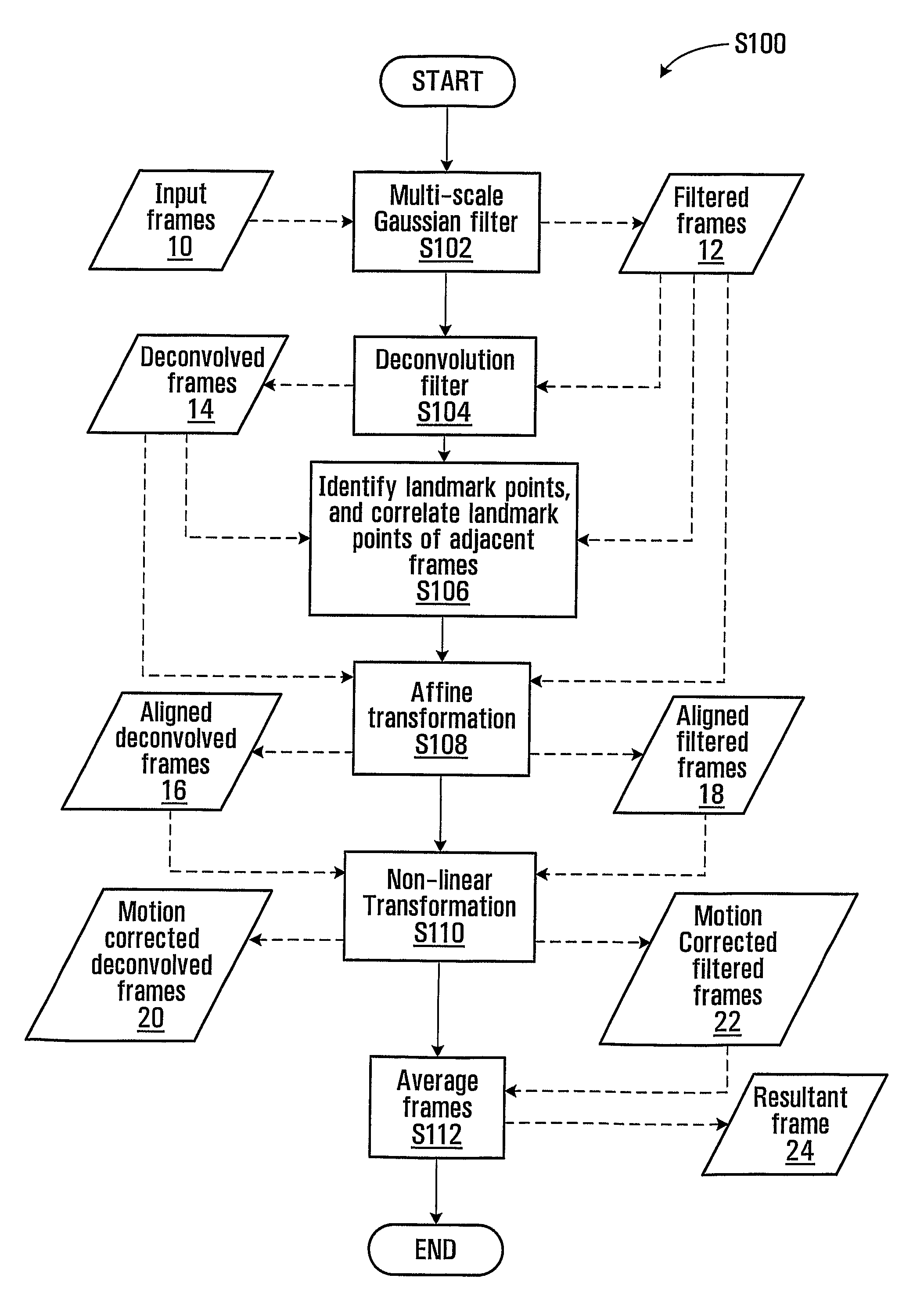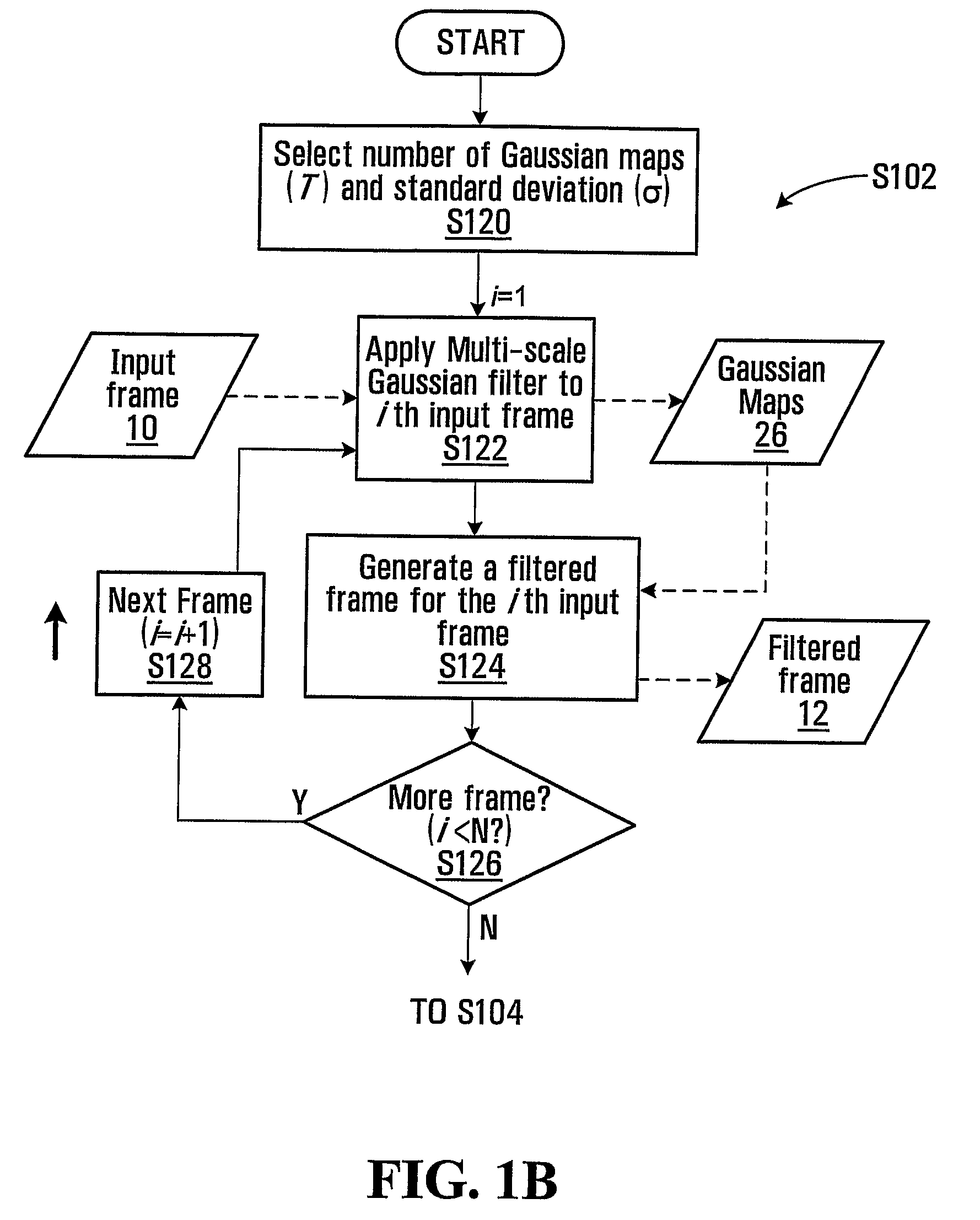Motion compensated image averaging
a technology of image averaging and motion compensation, applied in the field of image averaging, can solve the problems of difficult analysis of images using conventional techniques, low snr in gfap-gfp images of the mouse retina, and poor or satisfactory results
- Summary
- Abstract
- Description
- Claims
- Application Information
AI Technical Summary
Benefits of technology
Problems solved by technology
Method used
Image
Examples
examples
[0130]Example image frames were processed according to the process S100 using computer 200.
[0131]The processes used for processing these image frames included an algorithm which is illustrated with the following pseudocode:
[0132]
======================================%% Begin PseudocodeLoop from i =1 to N{execute subprocess S102 to generate filtered frame Ifi from rawframe Iiexecute subprocess S104 to generate deconvolved frame Ji fromfilteredframe Iiexecute subprocess S160 to identify landmark points in JiIf i > 1{execute S162 to correlate landmark points in Ji and Ji−1execute S108 to align Ifi with Iai−1, generating aligned frame Iaiexecute S110 to correct alignment of Iai to Irefi−1, generatingcorrectedframe Ini and reference frame IirefIA = [(i−1)*IA + Ini] / iELSEIA = Ifi} end if i >1} end loop from i = 1 to N%% End Pseudocode=========================================
example i
[0133]A sample raw frame of a GFAP-GFP image of a mouse retina taken in vivo and processed in this Example is shown in FIG. 3A.
[0134]FIG. 3B shows a deconvolved frame generated from a filtered frame which is in turn generated from the raw frame of FIG. 3A, after the application of a multi-scale Gaussian filter and a deconvolution filter. As can be seen, the underlying features in the image were enhanced without significant distortion in FIG. 3B. This result indicates that, in this case, subjecting the filtered frame to deconvolution facilitates accurate estimation of the underlying fluorescence signal in the filtered frame.
[0135]FIG. 3C shows a comparison frame generated from the filtered frame of FIG. 3B by applying a 9×9 median filter only. The underlying signal was less enhanced as compared toFIG. 3B. Some image artifacts were visible in FIG. 3C, but were absent in FIG. 3B.
[0136]FIG. 3D shows a comparison frame which was generated by simple averaging.
[0137]FIGS. 4A, 4B, 4C, and 4...
example ii
[0138]Raw image frames were obtained from the retina of two different mice having the FVB / N strain, using a Heidelberg Retina Angiograph (HRA2) system. A blue laser (488 nm) was used to excite the transgenic GFAP-GFP expression and the barrier filter was set at 500 nm. The field of view was originally set to 30° but the images displayed here are of a more localized region around the optic nerve head since this is the region of interest. All retinal images have a transverse resolution of 10 um. The raw retinal images were acquired over two weeks at specific time points (different days). At the onset of the experiment, immediately after retinal imaging on day zero, the control mice was injected with saline and the treated mice was injected with kainic acid, intraperitoneally. A sequence of raw images were taken each day and were averaged according to the process S100 as further detailed in the Example above to obtain a resultant image for that day. The parameters used for the averagin...
PUM
 Login to View More
Login to View More Abstract
Description
Claims
Application Information
 Login to View More
Login to View More - R&D
- Intellectual Property
- Life Sciences
- Materials
- Tech Scout
- Unparalleled Data Quality
- Higher Quality Content
- 60% Fewer Hallucinations
Browse by: Latest US Patents, China's latest patents, Technical Efficacy Thesaurus, Application Domain, Technology Topic, Popular Technical Reports.
© 2025 PatSnap. All rights reserved.Legal|Privacy policy|Modern Slavery Act Transparency Statement|Sitemap|About US| Contact US: help@patsnap.com



